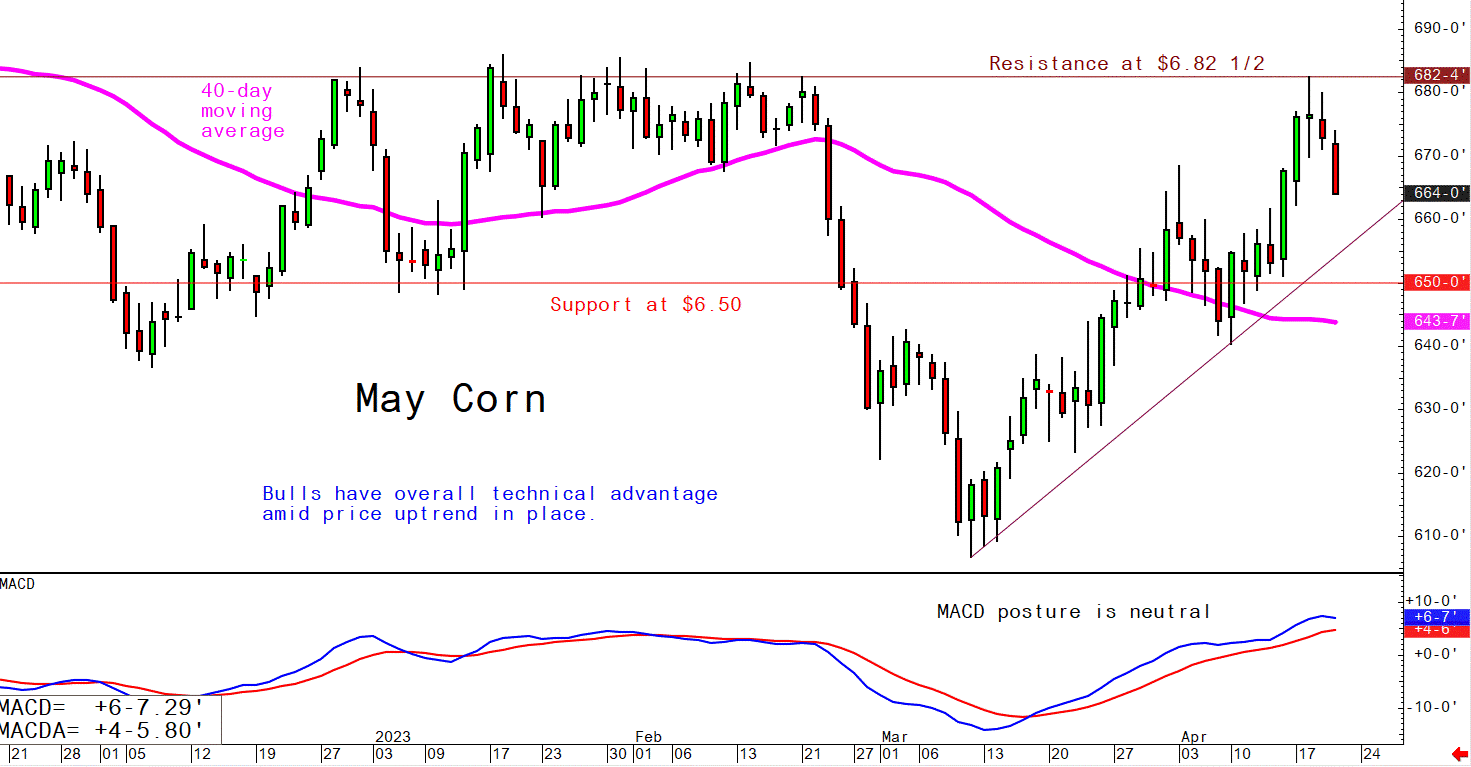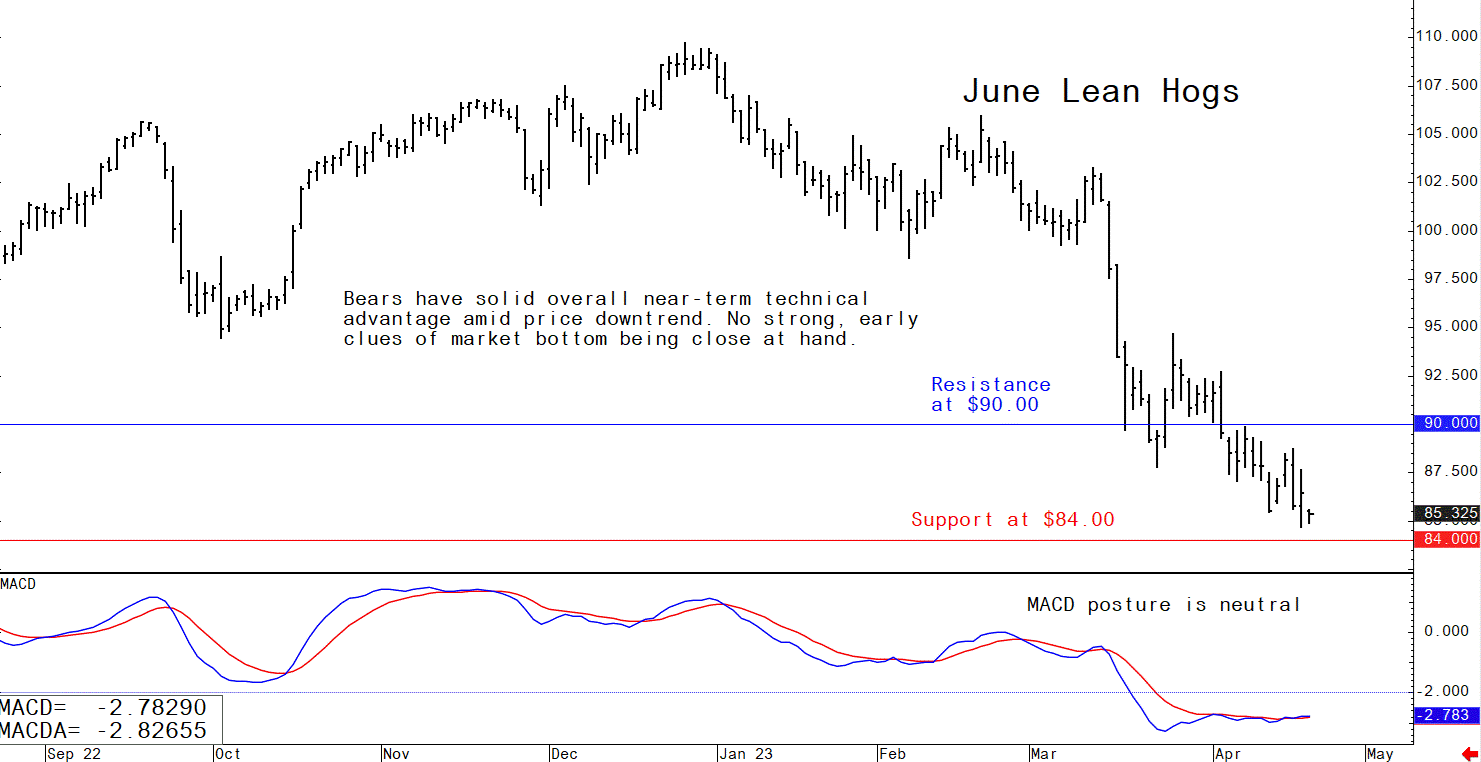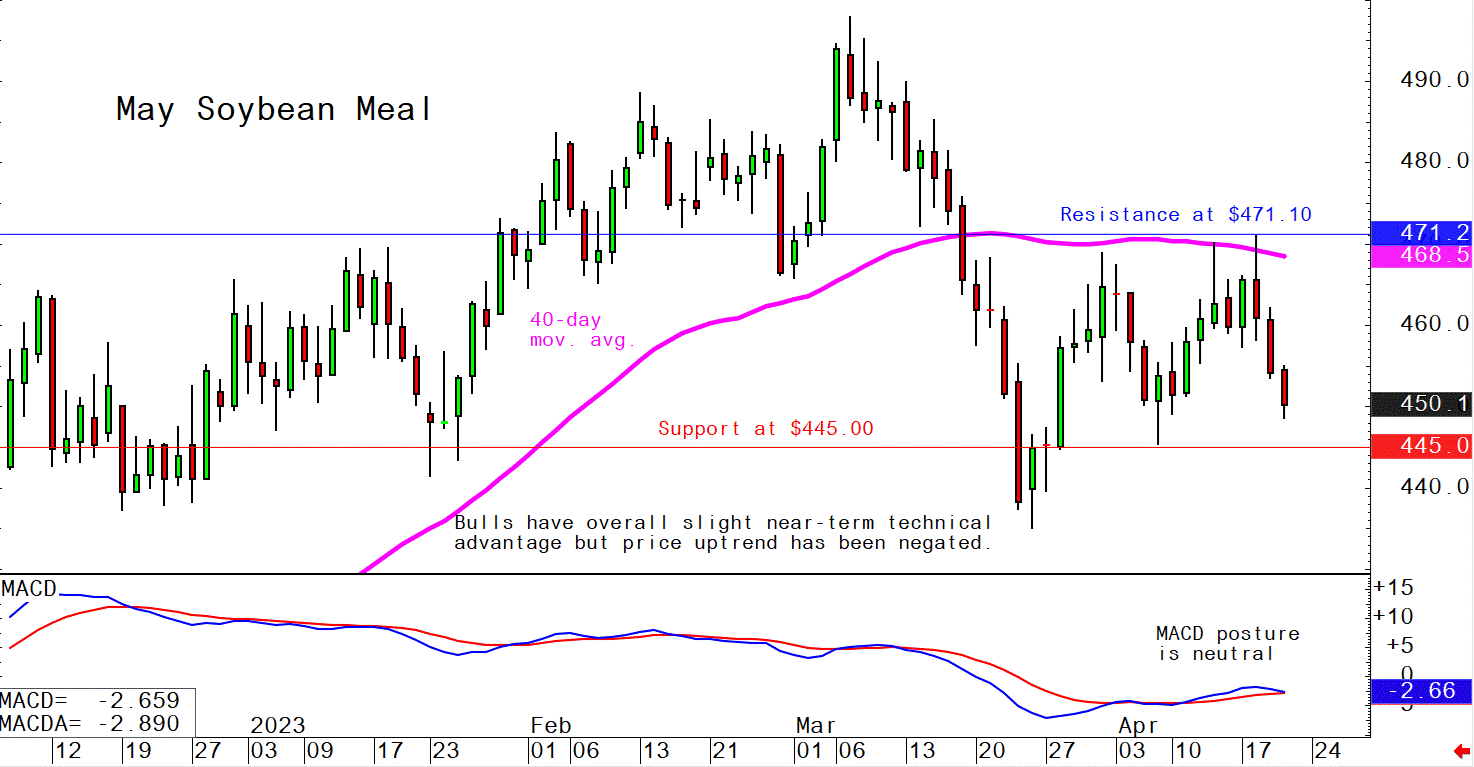



Pig outlook: China imports up, US '23 pork production reduced by 50M lbs
Analyst Jim Wyckoff shares an update on the US futures market, USDA reports and global pig newsTrader's perspective
June lean hog futures this week hit a fresh contract low and the bears continue to have the solid near-term technical advantage amid a price downtrend firmly in place on the daily bar chart. Summer-month lean hog futures continue to trade at premiums to the cash index, but traders have reduced those levels as they wait on the cash market to put in a low. The latest CME lean hog index is down 7 cents to $71.57 (as of April 18). Bulls are hoping for a seasonal rally in response to rising consumer pork demand during grilling season. Also, US hog supplies have begun dwindling toward annual lows in early summer. Demand for the various grilling cuts (i.e. loins for chops, ribs, butts for pork steaks, trimmings for sausage) and bacon in preparation for BLT season should give the wholesale market a significant boost in the coming weeks.
Weekly USDA pork export sales
Pork: US net sales of 36,100 MT for 2023 were up 33 percent from the previous week, but down 3 percent from the prior 4-week average. Increases primarily for Mexico (13,100 MT, including decreases of 200 MT), Japan (4,600 MT, including decreases of 300 MT), Australia (4,200 MT), South Korea (3,500 MT, including decreases of 300 MT), and Colombia (3,000 MT), were offset by reductions for Nicaragua (400 MT). Exports of 34,100 MT were down 8 percent from the previous week, but up 4 percent from the prior 4-week average. The destinations were primarily to Mexico (13,600 MT), China (5,500 MT), Japan (3,500 MT), South Korea (3,300 MT), and Canada
China pork imports increased in March
China imported 150,000 MT of pork in March, up 11.2% from last year. During the first three months of this year, China imported 530,000 MT of pork, up 27.7% from the same period last year.
China’s Q1 pork output hits five-year high
China’s pork output in the first quarter rose 1.9% from year-ago to 15.9 MMT, the highest quarterly production since the fourth quarter of 2017. A spike in infections of African swine fever earlier this year forced many farms in the world's top pork producer to cull pigs, pushing up slaughter numbers. China slaughtered 198.99 million hogs in the quarter, up 1.7% from the same period last year. China’s pig herd, though 2% higher than the same period a year earlier, contracted from the prior quarter’s 452.56 million head to 430.94 million.
USDA Livestock Outlook
Pork/Hogs: Using information from the March Quarterly Hogs and Pigs report, the 2023 pork production forecast was reduced about 50 million pounds to 27.36 billion pounds, up 1.4 percent from total production last year. U.S. pork exports in February were 504 million pounds, almost 4 percent above same-period shipments last year. Expectations for continued strength of shipments to Western Hemisphere nations prompted a 30-million-pound increase of the first-quarter export forecast to 1.64 billion pounds, 6.1 percent higher than a year ago. Exports for 2023 are expected to be about 6.4 billion pounds, about 1 percent above those of 2022.
Mildred Haley NASS Revisions Explain Larger-Than-Expected First-Quarter Hog Slaughter Numbers Federally inspected hog slaughter numbers for the first quarter of 2023 were about 32.4 million head, 3 percent higher than a year ago and larger than initially anticipated. Much of the unexpected slaughter numbers was explained in the Quarterly Hogs and Pigs report, published on March 30, 2023. The report revised second-half 2022 farrowings upward by 98 thousand head, yielding an additional 1.1 million pigs born during the June–November period. About half of the revised number of pigs was likely slaughtered in the December–February 2023 quarter, with the other half—born in September– November—likely to be slaughtered in the March–May 2023 quarter.
The weight categories provided in the March report suggest that the industry has already worked through and processed most of the revised increases in the pig crops; only the heavy hog category— 180 pounds and over— exceeds its year-earlier level, in this case by 2.1 percent. Processors are expected to fully utilize this weight category about two-thirds of the way through the second calendar quarter of 2023. Based on the revised September–November farrowings and pig crops, the second[1]quarter 2023 pork production forecast is increased by about 95 million pounds.
Second-quarter 2023 pork production is expected to be about 6.6 billion pounds, about the same as a year earlier. The report indicated that slightly smaller December–February farrowings—0.3 percent smaller year over year, combined with a fractionally larger litter rate, 11.02 pigs per litter in 2023 versus10.95 in 2022—will result in a December–February 2023 pig crop that is 0.35 percent larger than a year earlier. This slightly larger pig crop should result in a scant increase in third-quarter pork production of about 0.9 percent, to about 6.6 billion pounds. Hog producers indicated intentions to farrow 2.93 million sows in the March–May (spring) quarter of this year. Animals born from these resulting litters are mostly processed in the fourth quarter of the calendar year.
If producers follow through on their stated intentions and litter rates stick to fractional trend increases—along with expectations for somewhat-stronger average dressed weights—fourth-quarter 2023 should reach 7.1 billion pounds, about 2 percent above a year ago. For the year in total, 2023 pork production implied by information from the March Quarterly Hogs and Pigs report should reach 27.4 billion pounds, about 1.4 percent higher than production in 2022. If first-quarter prices are any indicator for the new year, 2023 is shaping up to be a tough one for hog producers and processors alike.
Live equivalent prices for 51–52 percent lean hogs averaged $54.83 per cwt, more than 16 percent below a year ago. To the extent that the Iowa State University’s Estimated Farrow to Finish Livestock Returns are representative of comparable operations in hog[1]producing States, the breakeven for both January and February 2023 (the latest months for which data are available) are in the low $70’s range (on a live equivalent basis), implying that many hog producers sustained serious losses in the first quarter.
Weak Pork Demand Likely Contributing To Lower Hog Prices
Because demand for hogs derives from consumers’ demand for pork, persistently low values of the wholesale carcass cutout signal weak consumer demand, likely contributing to some extent to lower processor price bids for hogs. It is notable that the 2023 value of the pork carcass cutout has stagnated at about $80 per cwt into early April. Processors are likely hesitant to bid aggressively on hogs in an environment of stagnant pork prices.
Moving into the second quarter of 2023 and beyond, consumer pork demand is likely to be affected by economic tradeoffs necessitated by inflation’s impact on the prices of goods and services that consumers deem essential to maintain chosen living standards. Projected production increases for the balance of the year are likely to be a significant factor that pushes prices below year-earlier levels. Second-quarter prices are expected to respond to flat-to[1]fractionally higher production by declining to $60 per cwt, almost 21 percent below a year ago. The same dynamic will probably hold for both the third and fourth quarters: small forecast increases in pork production—0.9 percent in the third quarter and about 2 percent in the fourth quarter—should push prices lower to about $67 per cwt, almost 17 percent below a year earlier in the third quarter. For the fourth quarter, prices are expected to average $62 per cwt, about 2 percent below same-period prices in 2022. For 2023 as a whole, prices of live equivalent prices of 51–52 percent lean hogs are expected to average about $61 per cwt, more than 14 percent below the average in 2022.
Shipments to Western Hemisphere Countries Keep February Exports Year-Over-Year Positive
February pork exports were 504 million pounds, almost 4 percent above shipments a year ago. On balance, year-over-year lower shipments to Asia—Japan in particular—were largely offset by strong exports to Western Hemisphere countries, including Canada and the Dominican Republic. The listing of the 10 largest foreign markets for U.S. pork in February is noted below, along with February trade shares. It is notable that Western Hemisphere nations accounted for 57 percent of U.S. exports in February, while 35 percent of U.S. pork shipments were sent to Asia.
The next week’s likely high-low price trading ranges:
June lean hog futures--$84.00 to $92.00 and with a sideways-lower bias
May soybean meal futures--$445.40 to $471.10, and with a sideways bias
May corn futures--$6.55 to $6.86 and a sideways-higher bias
Latest analytical daily charts lean hog, soybean meal and corn futures












